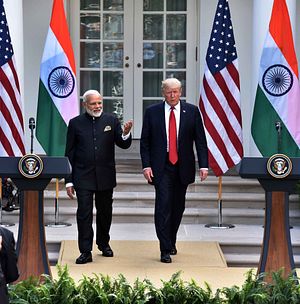The United States and India are poised to take a significant step toward institutionalizing bilateral strategic cooperation when their respective defense and foreign ministers conduct an inaugural “2+2” dialogue in New Delhi on September 6. The unprecedented 2+2 not only bears considerable symbolic value, but also stands as forensic bureaucratic evidence that the two governments are determined to find ways to operationalize comprehensive cooperation.
Every Indian prime minister in recent memory has rhetorically committed to ever more cooperation and alignment with the United States, but in practice, strategic convergence has lagged far behind. At the Shangri-La Dialogue in June, for instance, Prime Minister Narendra Modi highlighted the importance of promoting a common “rules-based international order” in the Indo-Pacific within which all nations can thrive as “equal and sovereign” entities — a decisive affirmation of the U.S. vision for regional security.
Notably, Indian strategists are adamant that the United States’ concept of a Free and Open Indo-Pacific Strategy also contain the word “inclusive” to ensure that it is framed as a broadly affirmative agenda for all countries in the region, rather than one aimed against any single actor. The reality is that, despite India’s reticence about provoking Beijing, considerable wariness of China’s coercive economic practices and growing military capability undergirds U.S.-India cooperation.
The United States has long considered India, a rising democratic power, to be a bastion of the liberal international order it holds dear, particularly in a region increasingly vulnerable to Beijing’s incursions. The George W. Bush administration’s landmark 2005 U.S.-India civilian nuclear deal was ultimately motivated by American conviction that a close partnership with India would be critical to sustaining a regional balance of power favorable to U.S. interests. In 2018, the U.S. Defense Department’s renaming of the U.S. Pacific Command to the “Indo-Pacific Command” highlighted the significance of India’s role in maintaining global stability and security. And the U.S. government’s reaffirmation of India’s status as a “Major Defense Partner” in the recently enacted National Defense Authorization Act (NDAA) for Fiscal Year 2019 cemented the importance of the U.S.-India defense partnership amid converging threat perceptions vis-à-vis China.
In addition to broadening the scope of pre-existing bilateral and multilateral military training and exercises, the 2+2 will give the United States and India a wider berth to coordinate information and technology sharing. This coincides with the U.S. Department of Commerce’s recent designation of India as a Tier 1 Strategic Trade Authorization level trade partner, which lifts a large swath of restrictions on U.S. companies’ export of dual-use items to India. And as bilateral trade continues to grow, the two countries will direct their attention to helping third countries that need targeted economic and development assistance — in Africa, Southeast Asia, and beyond. Finally, and more broadly, the two countries enjoy considerable accord on a range of other security priorities, including the determination to work toward establishing a durable peace in Afghanistan — a war that has occupied U.S. troops for the past 17 years.
But despite the remarkably positive trajectory of the U.S.-Indian relationship over the past decade, convergence and cooperation have not eclipsed all conflicts of interest between the two countries. One enduring obstacle is the Trump administration’s implementation of full-blown sanctions on Iran, to take effect in November, which complicates India’s quest for regional trade partners to sate its growing demand for petroleum. In 2017, India imported almost 40 percent of its oil from Iran, making it the second-largest importer of Iranian crude, behind China. India’s cooperation with Iran transcends energy trade to include its $200 million investment this year alone in Iran’s Chabahar port, which carries significant strategic value for India as it reduces transportation time and costs for Indian goods being transported to Central Asia and Russia.
India’s arms purchases from Russia also pose a meaningful challenge to its defense relationship with the United States. As New Delhi moved forward with its purchase of the advanced S-400 air-defense missile system from Russia as part of a $6 billion deal it struck with Moscow in late 2016, it became a target for sanctions under the Countering America’s Adversaries Through Sanctions Act (CAATSA), which seeks to punish Russia’s defense and intelligence sectors. Though the recently enacted NDAA contained a waiver that conditionally excludes India from CAATSA sanctions, New Delhi’s purchase of Russian equipment will remain a point of tension in its relations with Washington.
The United States has wagered that it can rely on India to reinforce a favorable balance in the Indo-Pacific amid China’s coercive diplomacy and geopolitical ambitions. As the U.S.-India strategic partnership emerges as one of the most important bilateral relationships of the 21st century, forums such as the 2+2 ministerial dialogue provide the two countries with a critical opportunity to deepen their interoperability through practical measures. Indeed, unless the two countries maintain significant, uninterrupted momentum in coordinating diplomatic and security priorities, the United States’ regional strategy for a free and open Indo-Pacific will become increasingly brittle.
Dr. Patrick M. Cronin is Senior Director of the Asia-Pacific Security Program at the Center for a New American Security, and Kristine Lee is Research Associate with the Asia-Pacific Security Program.

































